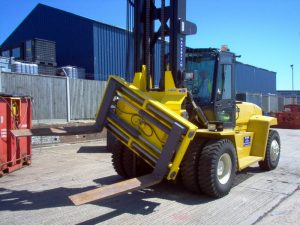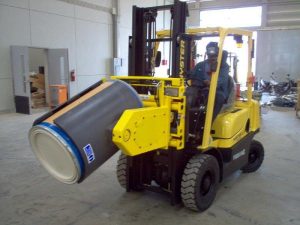Forklift Attachments
When it comes to handling a wide variety of materials in a supply chain or warehouse, you can’t limit yourself to standard pallet forks. To satisfy customer needs, or diversify your offerings, you should be able to move and stock a variety of orders. That may require different types of forklifts, or at least specialised forklift attachments.
Sideshift
Probably the most common attachment is Sideshift. Sideshift allows both forks to move side by side horizontally to better align with pallets. This lets the lift operator make small adjustments in racking without having the move the entire lift truck around.


Fork Positioners
Similar to sideshift, fork positioners let the tines move horizontally, but in a different way. Fork positioners let you move the tines closer together or further apart, letting an operator adjust to different types of pallets or handle non-standard materials.
Rotators
Like the name implies, fork rotators allow the plane of the fork tines to rotate in either direction. These allow for dumping or repositioning of lopsided pallets, without the need for a specialised lift truck or personnel.


Clamps
There are several types of forklift clamp attachments, but they all accomplish the same basic task: gripping and handling large, non-standard sized loads. The most common forklift clamps you’ll find include:
- Paper roll clamps
- Carton clamps
- Drum clamps
- Bale clamps
Push-Pull Attachments
Push-Pull attachments or just “push pulls” are a space-saving attachment that let you stack materials without the need for pallets. Using a flat surface and a pushing edge, push-pulls allow an operator to slide orders off onto slip sheets.


Multi-Pallet Handlers
Multi-pallet handlers are attachments that allow a forklift to lift two pallets simultaneously using multiple fork tines. Operators must be aware that multi-pallet handlers do not increase the load capacity of any forklift.
What to Know About Forklift Attachments - A reminder
Equipment managers and forklift operators should know more about forklift attachment than just what they do. Here are a few things that your team should always keep in mind when dealing with them.
- All operators should be trained on all new forklift attachments you’re using, even if they’ve previously been trained on the same forklift without the attachment.
- The forklift attachments themselves do count towards your lift truck load capacity. Be sure to keep this in mind when working.
- When using a new forklift attachment, the weight distribution will likely be different from the forklift’s standard use without that attachment. This is one of the reasons additional training is a necessity.
- For legal purposes, any forklift outfitted with an attachment is technically “partially loaded,” even if the forklift itself isn’t carrying a load.
